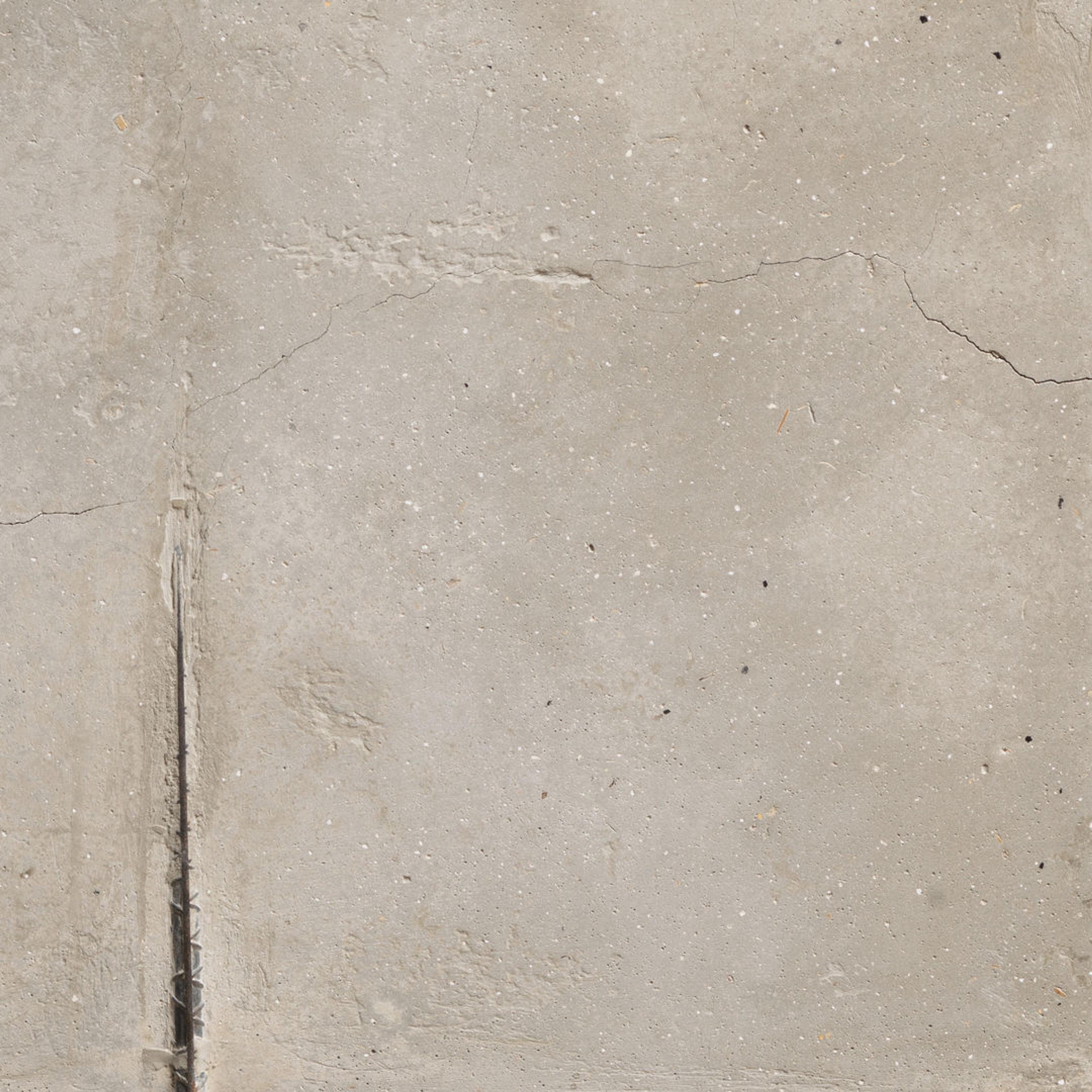Read the show notes and illustrated transcript below.
Listen and subscribe to Immaterial on Apple Podcasts, Spotify, YouTube, Pandora, or wherever you get your podcasts.
Show Notes
Concrete. Love it or hate it, it’s completely unavoidable in the modern world. It contains many dualities; it can be as smooth as marble or so rough it tears your skin. In summer, it retains heat; in winter, it amplifies the cold. It’s liquid but can turn hard enough to hold up elevated highways and dam rivers. It’s not just a cheap construction material for official buildings or the poignant centerpiece of brutalist architecture, it’s a substance that has been transforming the world around us for more than two hundred years. But what makes concrete truly divisive is the way it communicates power… simply by existing.
In this episode, you will meet some curators at The Met with very strong opinions about concrete. According to architecture curator Abraham Thomas, it was seen as a “sort of utopian material” that inspired “bold new visions for architecture” but failed to live up to these aspirations through no fault of its own (although that didn’t stop Frank Lloyd Wright from choosing it as the ideal medium for creating his textile block houses). Architecture expert Adrian Forty lays out the importance of concrete to the rebuilding of the world after World War II, and explains how its strength makes it a poignant and powerful tool for the construction of memorials. Met scientist Marco Leona dives into the chemistry of concrete (spoiler alert: it’s more of a kind of material than one specific formula), as well as the ways empires and autocrats have employed concrete as a means of expanding their rule.
The second half of this episode focuses on Colombian artist Doris Salcedo, who has been using the material in her art for decades, developing a vital, sharp, and evocative visual language that responds to violence in its most abstract and universal sense. In one very special work of art in The Met’s Modern and Contemporary galleries, Untitled, Salcedo uses concrete to create a memorial that evokes an overwhelming feeling of absence while acting as a catalyst for internal reflection and public dialogue about trauma and grief. Modern and Contemporary Art curator Iria Candela describes the importance of Salcedo’s work, her relationship to concrete, and the journey her work took to arrive at The Met.
Listen for the whole story, and scroll through the gallery below to take a closer look at the art mentioned in the episode and some highlights made from concrete in The Met collection.
Transcript
CAMILLE DUNGY: I want to tell you about a big old manor house in Norfolk, England with church-like stained-glass windows, wood-paneled walls, minaret towers, and a grand staircase carved from English oak. The house is at least 400 years old, and it’s a crumbling mess.
[Dramatic music]
CAROLINE QUENTIN (Restoration Home audio): Old Manor is on her last legs, beset with damp, wood worm, and death watch beetle. I’m going to be following the fortunes of six properties all facing their own struggle for survival.
DUNGY: This is a British TV show called Restoration Home, where we watch historic wrecks transform into dream houses right before our eyes. Honestly, I love the drama. And the problem with this old manor is that the walls are falling apart.
MAX (Restoration Home audio): Unfortunately, in the sixties this grayer stuff is the concrete render that the sixties people decided to spoil the house with, which is not allowing the oak beams to breathe. They all got dry rot and woodworm and everything due to the fact that they put this on.
DUNGY: The gray stuff is concrete. It’s trapping the moisture within the walls, which is causing the original wood to rot.
NADINE ORENSTEIN: With concrete… big mistake. It’s like the kiss of death [laughs] to that building.
DUNGY: Nadine Orenstein watches these architecture shows sometimes when she needs to unwind. And yes, there are a bunch of them. She’s the Curator-in Charge of The Met’s Department of Drawings and Prints, and she finds these shows fascinating. In part because when you start to pay attention to materials, you start to notice their patterns.
ORENSTEIN: It’s always the case that when someone takes over something that has Elizabethan bones in it and it has been restored in concrete, like the architect or the designer will be like, ‘Oh my God, we’re in big trouble.’
DUNGY: This tendency to use concrete as a sort of architectural Band-Aid is one reason why the material gets a bad rap.
ORENSTEIN: I grew up in New York in the sixties and seventies. I hate concrete. It has like… it has no decoration. It’s plain. It’s white. You know, in the summer it’s like hot… blinding. It’s not welcoming, it’s not warm. It doesn’t fill you with emotion. It’s like just… it’s there. You fall, you hurt yourself. It’s just that, like I… I don’t like it.
DUNGY: Nadine is definitely not alone in her distaste for concrete. But she sits on the other side of a debate where people will tell you how they love concrete. In fact, what kept coming up with everyone we spoke to about concrete is that no one can agree on it. Concrete can mean structure and endurance. It’s been a utopian promise. It’s been an industrial downfall. Used to make cities or, depending on who you ask, ruin cities.
But perhaps as a material in art—and as a reality in the infrastructure of our world—concrete is most interesting when we consider a ‘both/and’ approach. It’s literally about the gray area.
From The Metropolitan Museum of Art, I’m Camille Dungy and this is Immaterial, where we look at materials commonly used in making art and explore what the materials themselves can tell us. This episode: the power and politics of concrete. We’ll look at how it’s been used as a building block and why. We’ll meet a Colombian sculptor whose work with this durable material reminds us of the fragility of human life. And we’ll look at how, when concrete is used to memorialize, the message can be complicated.
[Music, echoing sounds of metal dragging against concrete]
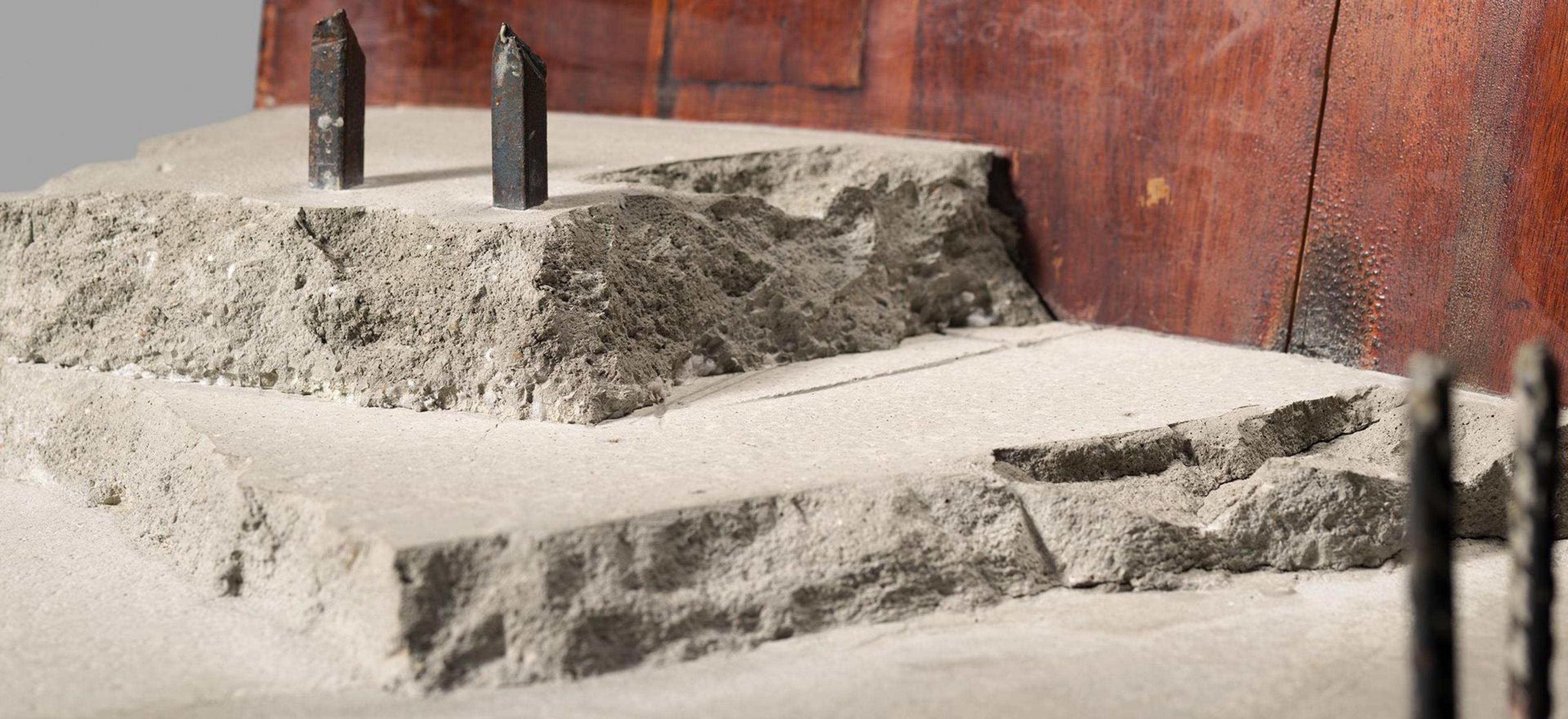
Doris Salcedo (Colombian, b. 1958). Untitled (detail), 1997–99. Wood, concrete and steel, 32 x 15 1/4 x 16 1/2 in. (81.3 x 38.7 x 41.9 cm). The Metropolitan Museum of Art, New York, Purchase, Lila Acheson Wallace Gift and Latin American Art Initiative Gift, 2020 (2020.25)
Concrete seems to evoke only the strongest emotions in people.
ABRAHAM THOMAS: In the UK, we have this thing called Marmite, have you heard of Marmite?
[Music: riff from the song “Low Rider” by War]
There’s a classic thing that Marmite, like either you love it or you hate it.
[Song lyric: “I hate marmite.”]
I quite like Marmite. It’s very divisive.
[Montage of unidentified voices: I’m a Marmite lover. It tastes like bin juice. I hate it! I hate it!]
THOMAS: People often talk about… like in any kind of conversation, people will use Marmite as a metaphor. Like, ‘oh, it’s quite like a Marmite situation.’
DUNGY: Abraham Thomas frequently eats his Marmite on toast, along with some tea. He’s the architecture curator in the Department of Modern and Contemporary Art at The Met.
THOMAS: I feel that concrete is the architectural world’s version of Marmite because people do love it or hate it. In a way that doesn’t really happen with wood or glass or ceramics, rather… perhaps more kind of socially neutral materials, maybe. And I think part of that reason is this extraordinary blending of concrete as this sort of utopian material which held so much promise in terms of building affordable social housing or bold new visions for architecture versus the kind of… There’s a sort of disappointment and sort of failed dreams of those visions we can’t really blame concrete for.
DUNGY: People can’t even agree on what concrete is. In 1928, the architect Frank Lloyd Wright published an essay where he asks, is it stone? Is it plaster? Is it brick or tile? Cast iron? The answer to every question was both: yes, and no. “Poor Concrete!” he wrote. “Still looking for its own in the hands of man.”
The word ‘concrete’ itself describes the combination of the materials that go into making it because the materials come together to form some thing that is concrete, as opposed to something abstract.
Identity crisis or not, concrete was the material of choice for Frank Lloyd Wright’s series of textile block houses where he hoped to take what he called “the cheapest (and ugliest) thing in the building world,” and turn it into something “permanent, noble, and beautiful.”
If you spend enough of your time around concrete architecture or contemporary art that uses concrete, you too may start to notice the material in deeper ways.
ADRIAN FORTY: So if you’ve got a lot of concrete, it will either retain coolness or emit warmth. And it… it will accumulate that and hold whichever it is over quite a long period of time. If it’s cool, it’ll feel colder. If it’s warm, it will probably feel warmer.
DUNGY: This is Adrian Forty, a man who spends a lot of time thinking about the many meanings of concrete and teaching them to his architecture students. He likes wrestling with questions like, ‘is concrete even a modern material?’ Short answer: it’s complicated. But that’s why Adrian is drawn to concrete: its contradictions.
FORTY: Because it can be both rough and smooth. It can be like marble. But equally it can be dangerously rough, with the risk of injuring yourself on it. It has this extraordinary kind of range. And that idea of smooth and rough, actually, it was, you know, one of the sort of trigger interests of mine and, and in thinking about it, is it embraced these extremes of sensuous appeal, and equally that sensuousness, can make it both repellent and attractive.
DUNGY: In those British restoration shows—which are by turns goofy and dramatic and informative—we see the ways that concrete can seem like the perfect material to cover up or repair the damage of the past, to build some kind of better future. And yet, the legacy it often leaves turns out to reveal even more crumbling and deterioration.
[Music]
MARCO LEONA: The fact that you can look at something that is an everyday material—a low, cheap material—that we think of as modern, but really as a technology, as a concept and as a way of making things, goes back to the very beginnings of history, technology, building. I think that if you want—is what excites me—things are not as simple as they look. And that technology really is a way to connect to the past.
DUNGY: Marco Leona tells me that its ability to appear as both modern and ancient at the same time is yet another one of concrete’s dualities. I was delighted to learn that Marco’s job at The Met is not as an art curator, or a conservator, but a chemist. In a basement lab, far from the ornate halls of the museum, he and his team figure out what works of art are made from.
He says his earliest memory of concrete was scraping his knuckles against these big concrete planters in his grandparents’ backyard. He must have been about five or six, he says. But when he thinks about concrete, he doesn’t think about its roughness ... he thinks about alchemy.
LEONA: You’re literally making it from dust, lesser stone, water and air. So what can be more alchemical than that? The key element for me… it’s the transformative nature of concrete. Concrete is making rock stone when there wasn’t any.
DUNGY: Instead of, say, taking a big piece of rock from a quarry and carving it into smaller rocks to build with, Marco says that in some ways, with concrete, you’re creating something from nothing.
The process for baking some bread (something Marco also does) is to combine yeast, water, flour, and salt. Similarly, the ingredients for concrete—at least the ancient, original concrete—are water, air, and a rock called pozzolana. And this is how the Romans made it. They used this simple concrete to construct buildings like the Pantheon, whose concrete dome is still standing today, two thousand years later. But Marco says that the Roman use of concrete is interesting for another reason.
LEONA: Concrete is the tool of the colonizer. You could say, oh, the Romans… empire builders. They built roads. They built monuments. There weren’t roads before they arrived.
Looking at it in a historical perspective, this is exactly what happens when you have a strong central government that wants to expand its powers outside the narrower confines of whatever their earlier sphere of influence. You need logistics. You need to build roads to transfer your troops, to transfer provisions, to transfer people, to exact tribute, to control your subjects. You need buildings that will signify your presence that will fortify your presence. And concrete is that tool.
DUNGY: Marco says if you fast-forward two thousand years, concrete is still that tool. Just look at Benito Mussolini’s fascist sweep of Ethiopia, Eritrea, Somalia, Libya, and Albania after World War I.
It’s worth noting that the concrete used in the Italian fascist architecture was technically different than the concrete the Romans used to colonize. The concrete Mussolini used was invented in the late 1800s. It’s known as Portland cement. And according to the architecture professor Adrian Forty, this modern concrete is everywhere.
FORTY: We produce something like five tons of concrete a year for every person on the planet.
DUNGY: Five tons. That’s like the weight of ten pianos per person.
FORTY: It’s an extraordinary figure. You think of the resources and the effort, the energy, you know, the sheer muscle power that’s gone into producing that. And you kind of wonder, ‘well, you know, where has your five tons of concrete gone this year?’
DUNGY: Maybe it’s become part of a high-rise in Tokyo, or one of the largest dams in India. It’s helped create a fortune for the wealthiest man in Africa, a Nigerian billionaire named Aliko Dangote, who operates sub-Saharan Africa’s largest cement company.
But you don’t have to be an industrialist billionaire to make concrete. You can make it yourself. Just go pick up an eighty pound bag of Quikrete for under five bucks at your local hardware store.
FORTY: I can remember mixing up some concrete and making concrete in a matchbox and casting a matchbox of concrete. I think that’s the first time when I kind of really was aware of it as… as a substance that could be fabricated. And, you know, you had something that was gloopy and it turned out to be hard.
DUNGY: This is Adrian Forty again, the professor who literally wrote the book on concrete’s dualities. Adrian says he was probably eight or ten years old when he made this concrete cast of a matchbox. That was when he first became fascinated with the transformational qualities of concrete.
FORTY: I grew up… it’s, you know, in the post-war period when there was a lot of reconstruction going on so truckloads of concrete were being driven around and poured all over the place as cities in Britain were being rebuilt.
DUNGY: Remember that crumbling British manor with walls layered in concrete?
Those walls were probably covered during this period, too, in the 1960s, when concrete was all the rage. This brings to mind two things I want to tell you about how to make something out of concrete.
The first thing is that the way you make a concrete object is by creating a mold and pouring—or casting—liquid concrete into that mold. This is true for every concrete building, too. So for every concrete item you make, you are essentially making it twice. The one is the inversion of the other.
The second thing is that any texture that is on your mold will get transferred to the final concrete version. Like, if you’re using a wood mold, then the details of the grain of the wood are going to show up as inverted wood grain on the concrete. So on the finished product, the echoes of the wood will always be there… like a ghost.
This, to me, makes something Adrian said all the more interesting, which is that concrete has become the default material for memorials.
FORTY: The whole objection to concrete is it creates this obliteration and forgetting of the past. That seemed to me to be a paradox. You know, maybe they have those connotations also. Mass, density, weight, gravity, you know, all these things somehow get sort of signaled and indicated through, through the concrete. And you know supposedly it’s indestructible, which is an issue with memorials because, against expectations, they don’t always last forever.
DUNGY: I want to talk about one concrete memorial that is still standing, and that Adrian says resonates with him. If you go to Paris, and make your way down the Seine river that cuts through the city, you’ll find two small islands. The bigger island, Île de la Cité, holds the Gothic cathedral Notre-Dame, which on a typical day you’ll find packed with tourists.
[Sounds of people and crowds on a Parisian street]
FORTY: It’s not a place where you would obviously expect to find a lot of concrete.
DUNGY: But walk away from the crowds to the other end of that island, and you’ll come upon a monument known in English as the Memorial to the Martyrs of the Deportation. It opened almost twenty years after the end of World War II, and asks visitors to remember the two hundred thousand people deported from France to the concentration camps.
FORTY: As you approach it, you can’t see it. You walk away from Notre-Dame, it’s behind you. You walk, I suppose eastwards, towards the tip of the Île de la Cité, there’s a little garden.
And then suddenly there’s a very steep staircase that drops down into this pit, which is down near the level of the river. But it’s completely enclosed in this very beautifully made, seamless concrete. So you… suddenly you leave a green space. And you go into this completely arid space with no vegetation in it, nothing except these concrete surfaces, and this small view of the river and the view of the sky above you.
So in a sense, it’s almost like a moment of sensory deprivation. So, you are enclosed in this little space.
DUNGY: From there you can enter what Adrian describes as a cave-like opening between two giant blocks of concrete. And inside the cave are thousands of tiny lights, each one representing a lost person.
[Ethereal music]
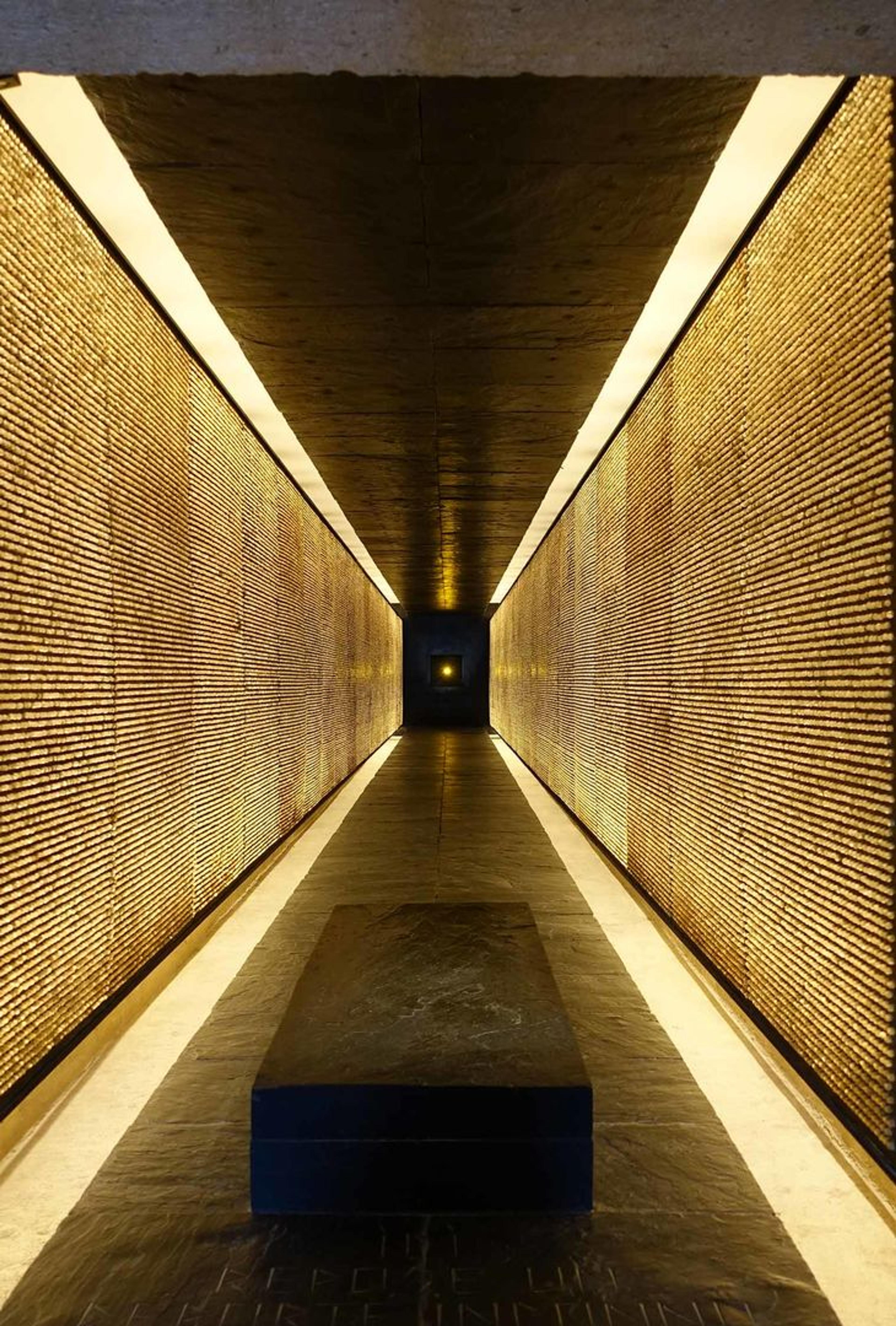
Mémorial des Martyrs de la Déportation. Guilhem Vellut from Paris, France, CC BY 2.0, via Wikimedia Commons
FORTY: You’re in, you know, one of the most historic points in, you know, a historic city, and weirdly you actually can’t see any of it. So it has a slight sort of eerie quality.
It throws everything back on, on you as the viewer. It makes, you know, you think about who you are, where you are. I think that’s why it’s effective. That effect of making you question your own identity as a viewer. Who are you looking at this?
DUNGY: Hearing Adrian describe this memorial, I can’t imagine it being made of anything but concrete. Concrete can speak to the collective and the individual, to moments that feel monumental and moments of solitude. It’s a material that’s both quiet and substantial enough to hold our grief. But memorials can take many forms. And there’s one artist who calls upon the power of concrete to explore mourning, grief, and memory. Her name is Doris Salcedo, and we’ll meet her after the break.
[Music]
DORIS SALCEDO: Memory, of course, is the essence of my work. I think if we don’t know our past, there is no way we can live the present properly. And there is no way we can face the future.
DUNGY: This is the artist and sculptor Doris Salcedo speaking in a 2004 video from the San Francisco Museum of Modern Art. She was born and lives now in Bogotá, Colombia, where the past she speaks of includes over five decades of conflicts between the government, paramilitary groups, and guerilla groups that’s left millions of people displaced, missing, assaulted, or dead.
Salcedo’s art asks viewers to pay attention to and acknowledge the reality of the violence, whether it’s her series of sculptures of household furniture full of concrete, performances to honor fallen activists, or installations involving melted weapons.
IRIA CANDELA: I think she’s one of the most fascinating artists living today.
DUNGY: Iria Candela, one of The Met’s curators of Modern and contemporary art, still remembers one of the most striking encounters she’s had with Salcedo’s work. It was 2007 and she was at the Tate Modern, a huge art museum in London that was built in a former power station. And some of that still remains, like the main hall, a vast, echoey, concrete, industrial space. It has a way of making you feel tiny when you're inside it. Iria remembers walking in there with its constant din from the thrum of visitors, and she noticed something strange.
CANDELA: You would encounter people looking at the floor. I can very vividly… can recall that image now because it’s not usual. When you go to a museum that would you look at the floor, you would normally look at, up into the altars, up into the walls, even on the, you know, the ceilings of, you know, of, of chapels or beautiful churches, right?
DUNGY: But there was no object people were looking at on the concrete floor. Instead, there was an enormous crack [SFX: cracking sound] down the entire length of the hall. Like a giant had carelessly stomped through the space and left destruction in his wake.
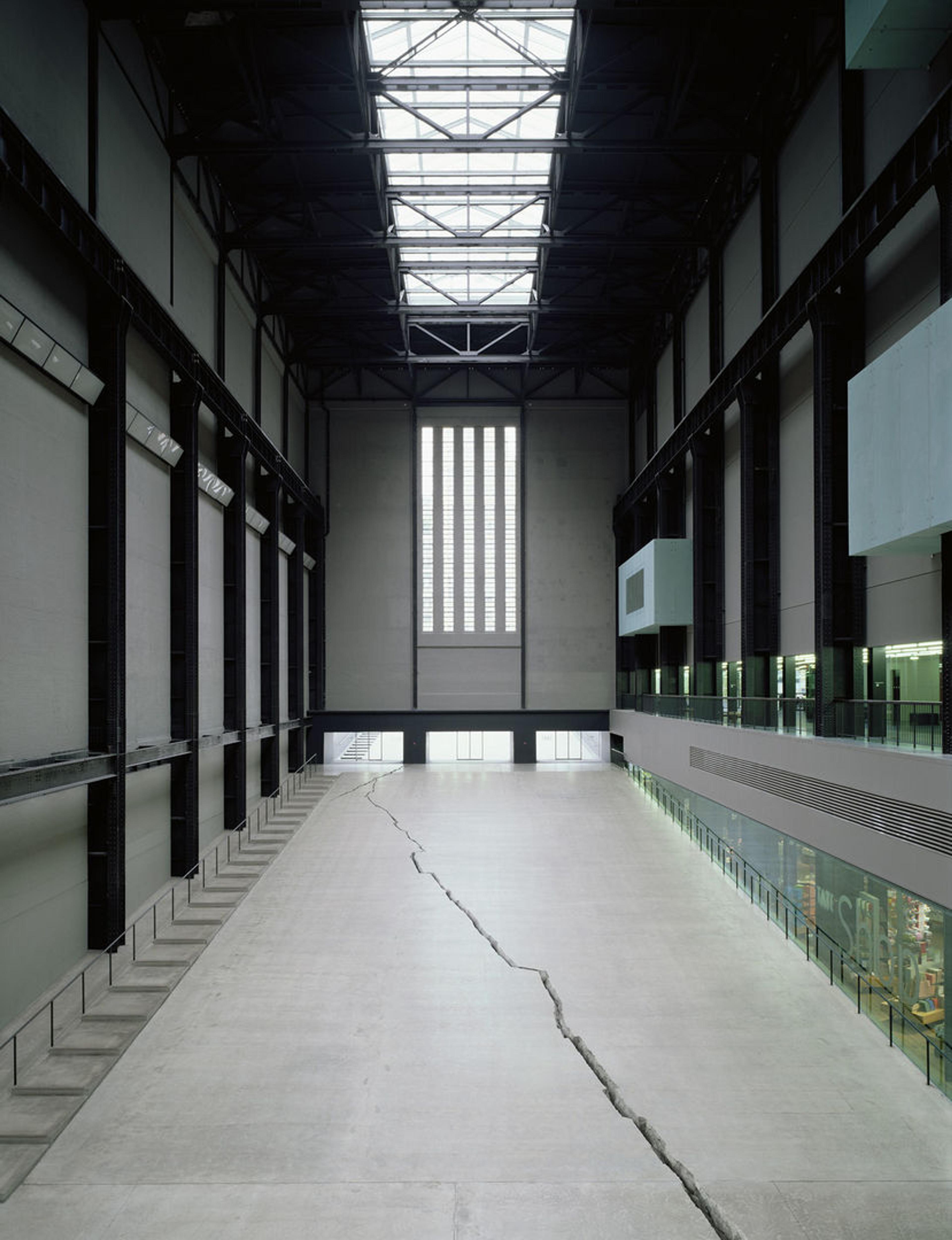
From Shibboleth, Shibboleth II, 2007. Doris Salcedo © Doris Salcedo, White Cube. Photo: Tate
CANDELA: I felt, um, intrigue. I felt a wonder. And… and people was also somehow challenged because you have to be careful not to fall within the crack if you weren’t paying attention.
DUNGY: Salcedo called the piece Shibboleth, a reference to a story in the Bible where people were forced to pronounce the word ‘shibboleth,’ and if they couldn't they were killed. Shibboleth can mean any word that is used to distinguish who is considered an insider and who is considered an outsider. Another duality, perhaps, that concrete can also reveal. Especially when it comes to issues like immigration.
SALCEDO: The title refers to dying when crossing borders, when you are recognized as somebody that is different. You’re the other.
DUNGY: Iria the curator has an additional interpretation of the crack in the concrete floor: that is about who is and isn’t welcome in spaces where art is shown. Who belongs in museums and galleries? Who is made to feel welcome? Whose stories are told? And from what vantage point?
CANDELA: It was precisely about questioning that sort of void or emptiness, or the, even the elephant in the room sometimes, when we talk about what museums are for. What is the value of art today, how art speaks to us, and how we relate and engage with others through art.
DUNGY: Shibboleth was open for six months and afterwards the crack was simply filled in with more concrete, leaving a permanent scar on the floor of the museum. Here, again, is Salcedo, speaking in a 2015 documentary by the Museum of Contemporary Art in Chicago.
SALCEDO: Every time a violent event takes place there is a scar. In these cases, I think it’s a very important part of the work that this wound remains. This memory of the event remains because still there are immigrants dying every day. So it is important that the wound remains.
DUNGY: Salcedo’s work with concrete—as well as her explorations of mourning and grief—began many years before the crack in the floor. Here’s Iria again:
CANDELA: Doris had gone to study abroad. But when she returned to Colombia in the late eighties, she very much had to kind of, come to terms or grasp to the notion of being an artist in a context that was so dramatically affected socially and politically by a long, long history of a conflict between the government and the guerillas. And the paramilitaries that had left, many civilians disappeared… and death… and that she felt she could not really embark seriously on a career as an artist or intellectual if she was not addressing that as a citizen of that country.
DUNGY: Salcedo started to ask questions. She sat with people whose lives had been changed by political violence and listened to their stories. Here’s Salcedo talking to the Nasher Sculpture Center in 2016:
SALCEDO: When I start a piece, it’s to make a piece for the person who has given me a testimony. Either a survivor or a victim whose experience I have researched. So it’s always an address to someone whose experience I think it’s important for all of us; whose experience in a way has protected us.
DUNGY: Those interviews informed much of Salcedo’s work with materials such as rose petals, cow bladders, wood, grass, needles, and water. And a series of untitled sculptures made from ordinary household pieces of furniture: beds, armoires, tables, and chairs. Salcedo has filled the negative spaces of each piece of furniture with concrete.
On a quiet afternoon, in the middle of a large, white gallery whose ceiling full of skylights throws a checkerboard pattern of sun and shadows across the floor… there, surrounded by colorful landscapes and portraits sits an inauspicious sculpture.
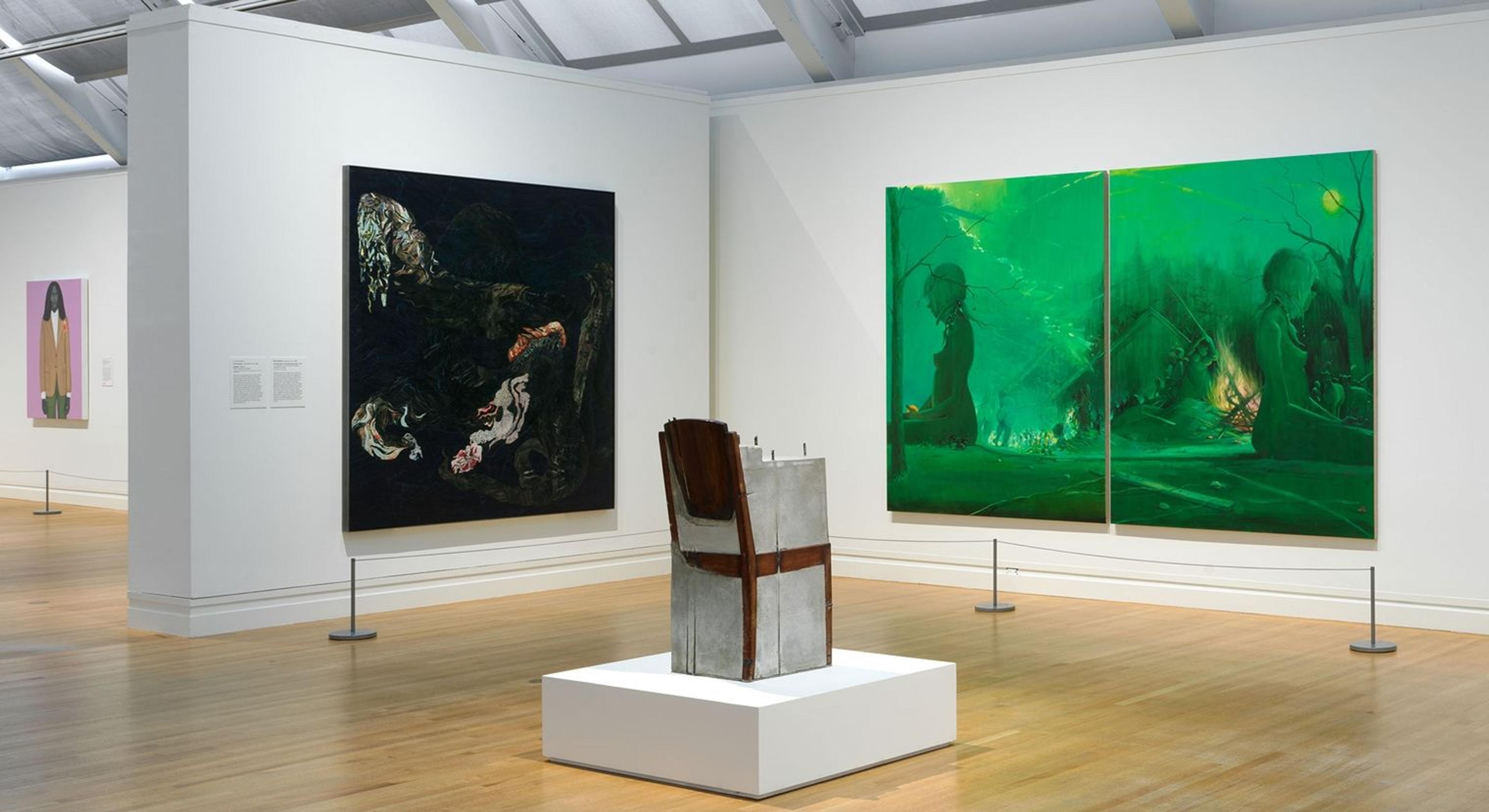
Doris Salcedo’s Untitled on view in Gallery 915
It is a brown wooden chair, an otherwise unremarkable, domestic object. And in the negative space of the chair—the space, perhaps, that a human might fill—there’s a solid block of concrete, penetrated by jagged rods of steel rebar. Iria refers to this untitled piece simply as “the chair.” Here’s Salcedo in a 2016 conversation at Harvard.
SALCEDO: When I began making these pieces, I was interviewing widows whose partners, both male and female, have been murdered. And I was interviewing these widows in their homes. So they were living with the objects that actually belonged to the deceased partner. And so these objects were constantly screaming the absence of that person.
So I wanted this huge silence to be present in the work. That’s why there are many of these pieces with concrete where the objects are just telling us about this absence.
[Music]
DUNGY: Iria the curator says it was her quest to bring a piece by Salcedo into The Met, which she says has been historically lacking in contemporary Latin American artists. And she spent years looking for a piece like this chair.
CANDELA: I love the scale because it’s a human scale. Basically it is taken… sticking a chair, very kind of humble, you know, common, regular, generic chair… wooden chair taken from a home in Bogota from a completely anonymous individual.
You can feel it and even smell it and touch it. The chair is for me one of the most direct metaphors of the human beings. It is one of our most incredible inventions. They remain such a useful, necessary, instrumental, reliable, fundamental object in our daily lives that very much define who we are. The chair is pretty much part of our bodies already. But then suddenly this concrete block that has taken up the shape of this chair is taking you to some sort of idea of an entombed object or presence.
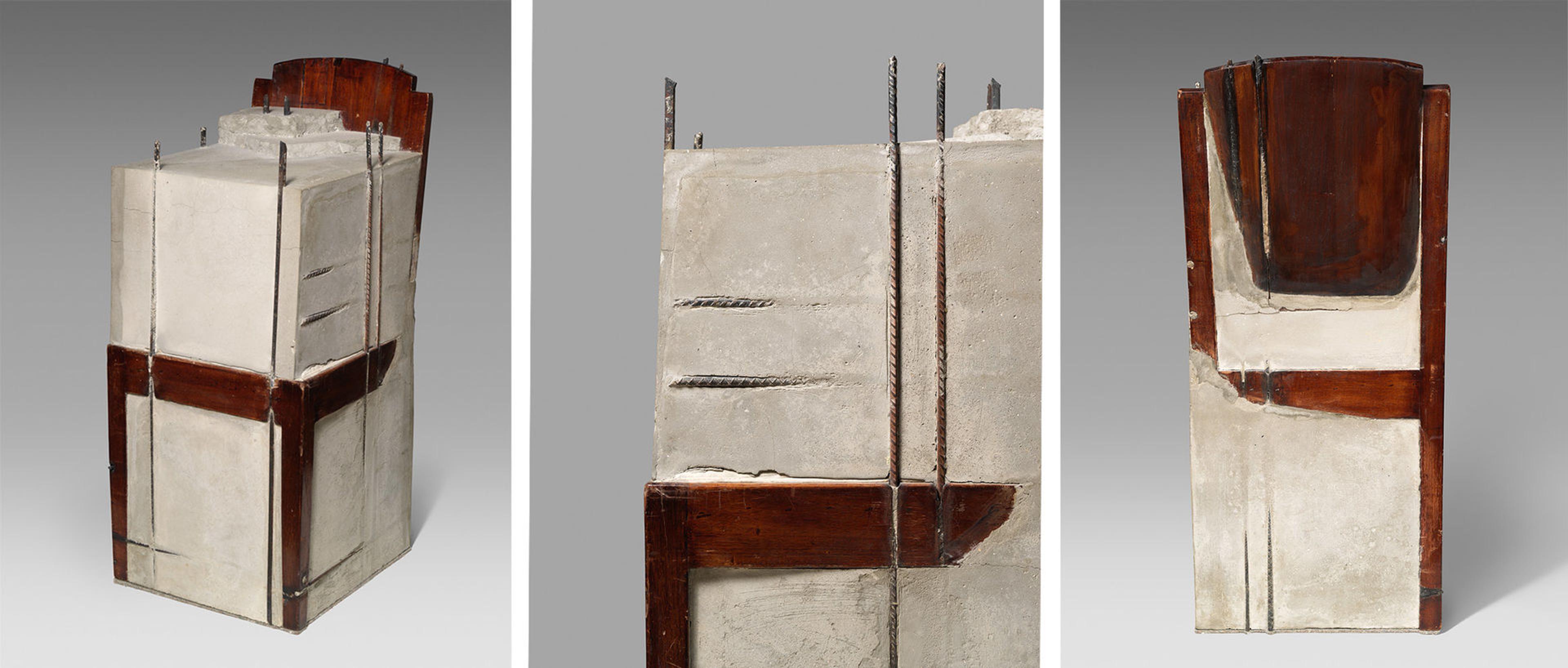
Doris Salcedo (Colombian, b. 1958). Untitled, 1997–99. Wood, concrete and steel, 32 x 15 1/4 x 16 1/2 in. (81.3 x 38.7 x 41.9 cm). The Metropolitan Museum of Art, New York, Purchase, Lila Acheson Wallace Gift and Latin American Art Initiative Gift, 2020 (2020.25)
SALCEDO: I think all of my work is about mourning. Every time a person is killed, there is an absence that is created in us, and their absence should be addressed. And that is particularly important in Colombia, or in countries where missing people are counted by the thousands, so all the funerary ritual that confirms the humanity of the person who was killed are missing, so they should be put in place. And I think that’s one of the tasks that I… that I’m addressing as an artist. That’s my task.
CANDELA: There’s a sentence that Doris said once, which is “there is nothing more human than mourning. It restores humanity.”
DUNGY: Iria says Salcedo’s role as an artist is similar to the role of a healer. Someone who creates a space in society where people can process their trauma. But, Salcedo says her art can only go so far in the healing process.
SALCEDO: It is very important to bring this past event, to bring them alive. But at the same time, I don’t think art can solve problems. I’m not doing anything for these families. I’m not doing anything for these victims. And that’s that… that’s a reality that we have to face when we talk about this type of art that is trying to address political issues.
Art does not give answers, only poses questions.
DUNGY: We build memorials, yet they remain an imperfect representation of our pain even as they allow us to bear witness. Salcedo seems to be bearing witness, too. She pushes us to fight back against a collective historical amnesia: amnesia for which concrete is also partly blamed. In the way people use it to cover nature; to obscure the past; to expand the arm of empire. Maybe it just does both: damage and repair.
[Music and the sounds of distorted voices]
FORTY: People will look at concrete and assume it’s mute, that it’s silent, that it doesn’t say anything. I would like people to be able to see it as something that’s rich with voices, that it says a lot of things. And those things are contradictory. They’re variable, they’re not fixed. They change all the time. I’d like to feel that people are attuned to that fluidity, that fragility of meaning, that courage within concrete and its sort of readiness to communicate in all sorts of different ways all at once.
[Music]
DUNGY: I’m still thinking about that question Adrian asked when we discussed the monument in Paris. The same one Iria implied about looking at the crack in the floor of the museum: “Who am I, looking at this?” Concrete is speaking to us about the ways we develop the world… or fight to preserve it. I wonder where my five tons of concrete will go this year. Concrete implicates us while asking us to reflect back on ourselves and the materials we use to build the world around us. So we listen, and try and figure out who we are.
—
DUNGY: For The Met, I’m Camille Dungy, and this is Immaterial.
[Music]
Immaterial is produced by The Metropolitan Museum of Art and Magnificent Noise.
This episode was produced by Eleanor Kagan.
Our production staff also includes Jesse Baker, Eric Nuzum, Elyse Blennerhasset, and Adwoa Gyimah-Brempong; and from The Metropolitan Museum: Sofie Andersen, Sarah Wambold, Benjamin Korman, and Rachel Smith.
Sound design by Ariana Martinez. Mixing by Ariana Martinez and Paul Schnieder.
This episode includes music composed by Austin Fisher.
Fact-checking by Christine Baird.
The podcast is made possible by Dasha Zhukova Niarchos. Additional support is provided by Bloomberg Philanthropies.
This episode would not have been possible without Nadine Orenstein, Drue Heinz Curator in Charge of the Department of Drawings and Prints; Abraham Thomas, Daniel Brodsky Curator of Modern Architecture, Design and Decorative Arts; Marco Leona, David H. Koch Scientist in Charge; Iria Candela, Estrellita B. Brodsky Curator of Latin American Art at The Met, and Brinda Kumar, Associate Curator of Modern and Contemporary Art.
Additional recordings by Laura Ubaté, and archival footage courtesy of the San Francisco Museum of Modern Art, the Museum of Contemporary Art in Chicago, Harvard Art Museums, and the Nasher Sculpture Center.
And a special thanks to Doris Salcedo.
I’m Camille Dungy.
###
